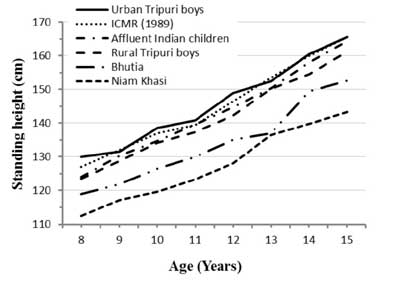Assessing the growth and nutritional status of
children and adolescents is an essential part of monitoring the health
of a population or a community [1]. Few studies [2,3] on tribal children
have been published from the northeastern part of India. The Tripuri
tribe constitutes more than half of all the 19 tribes found in the
state of Tripura and about 16% of total state population. The present
study was undertaken to assess and compare the growth and nutritional
status of Tripuri tribal adolescent boys (aged 8-15 years) from
rural and urban areas of West Tripura district.
This cross-sectional comparative study was conducted
in selected public schools in rural and urban localities of West Tripura
district. Data were collected from volunteers (258 rural and 365 urban
Tripuri tribal boys, aged 8 to 15 years), using random sampling
method. The socioeconomic status of each subject was assessed by
modified Kuppuswamy’s scale. Data were collected after obtaining assent
from each subject. The study was carried out in accordance with the
revised ethical guidelines for human experimentation of Helsinki
Declaration of 2000 [4]. Standing height (cm) and the weight (kg) was
measured following standard recommendations [5], and body mass index
(BMI) was also calculated. The age of each subject was recorded from
school register and cross-checked from birth certificates. Indices of
undernutrition such as stunting, thinness and overweight were calculated
according to the classification of World Health Organization (WHO) [6],
using the 2007 WHO growth reference data for 5-19 years [7].

(a) |

(b) |
|
Fig. 1 Plots representing the
comparison of (a) mean weight (kg) and (b) mean standing height
(cm) of rural and urban Tripuri tribal boys (aged 8 to 15 years)
of west Tripura district with other studies.
|
All the rural Tripuri tribal boys belonged to
the lower socio-economic class whereas urban boys belonged to the upper
middle socio-economic class. The overall prevalence of stunting,
thinness and overweight were observed 7.7%, 17.8% and 6%, respectively
for urban boys and 27.9%, 38.4%, and 0.39%, respectively for rural boys.
Stunting and thinness were more prevalent in rural boys compared to
urban boys, whereas prevalence of overweight was more in urban boys.
Occurrence of stunting and thinness were more in adolescent age (10 to
14 years) in rural boys. Figure 1 represents the
comparison of mean values of weight and standing height of Tripuri
tribal boys with Indian Council of Medical Research (ICMR) data [8],
affluent Indian children data [9] and the data available on urban
Niam Khasi of Meghalaya [2] and Bhutia of Sikkim [3]. The age
specific mean values for weight and height of rural and urban Tripuri
boys were above the respective values for Niam Khasi boys and
Bhutia boys. The urban Tripuri boys were close to the ICMR
reference data and were above the affluent Indian children data, but the
rural Tripuri boys were below the both references. Urban
Tripuri tribal boys were heavier and taller than the rural boys.
This rural-urban difference may be accounted for the different
socio-economic background they belong to, as also mentioned in
literature [1,10].
Acknowledgment: School authorities of all
primary schools for providing permission to carry out this work.
Funding: Tripura University; Competing
interests: None stated.
References
1. Oninla SO, Owa JA, Onayade AA, Taiwo O.
Comparative study of nutritional status of urban and rural Nigerian
school children. J Trop Pediatr. 2006;53:39-43.
2. Basu SK, Banik SD. Anthropometric
assessment of health and nutritional status of the adolescent Bhutia
boys and girls at Gangtok, Sikkim. Indian J Multidisciplinary
Research. 2006;2:149-60.
3. Khongsdier R, Mukherjee N. Growth and nutritional
status of Khasi boys in Northeast India relating to exogamous marriages
and socioeconomic classes. Am J Physical Anthropol. 2003;122:162-70.
4. Touitou Y, Portaluppi F, Smolensky MH, Rensing L.
Ethical principles and standards for the conduct of human and animal
biological rhythm research. Chronobiol Internat. 2004;21:161-70.
5. Weiner JS, Lourie JA. Practical Human Biology.
London:Academic Press; 1981.
6. WHO Physical Status: The Use and
Interpretation of Anthropometry. Report of a WHO Expert Committee. World
Health Organization, Technical Report Series no. 854. Geneva.
1995:1-452.
7. World Health Organization. Growth Reference Data
for 5-19 years. Available from URL:
http://www.who.int/growthref/who2007/en/index.html. Assessed November
10, 2010.
8. Indian Council of Medical Research. Growth and
Physical Development of Indian Infants and Children. ICMR Tech Rep
Series No. 18, 1989.
9. Agarwal DK, Agarwal KN, Upadhyay SK, Mittal R,
Prakash R, Rai S. Physical and sexual growth pattern of affluent Indian
children from 5 to 18 years of age. Indian Pediatr. 1992;29: 1203-82.
10. Oyhenart EE, Castro LE, Forte LM, Sicre ML,
Quintero FA, Luis MA. Socioenvironmental conditions and nutritional
status in urban and rural school children. Am J Hum Biol. 2008;20:
399-405.

